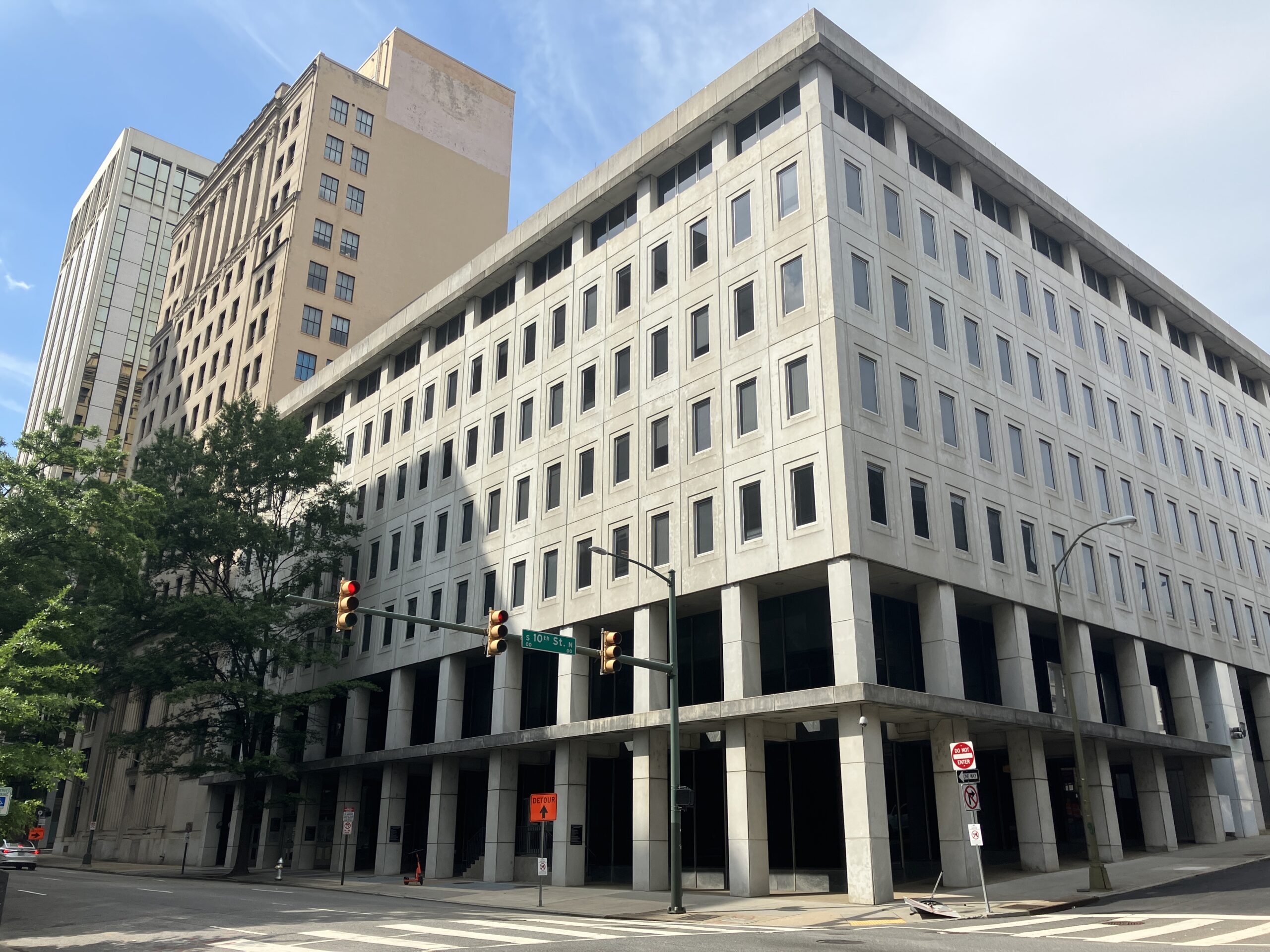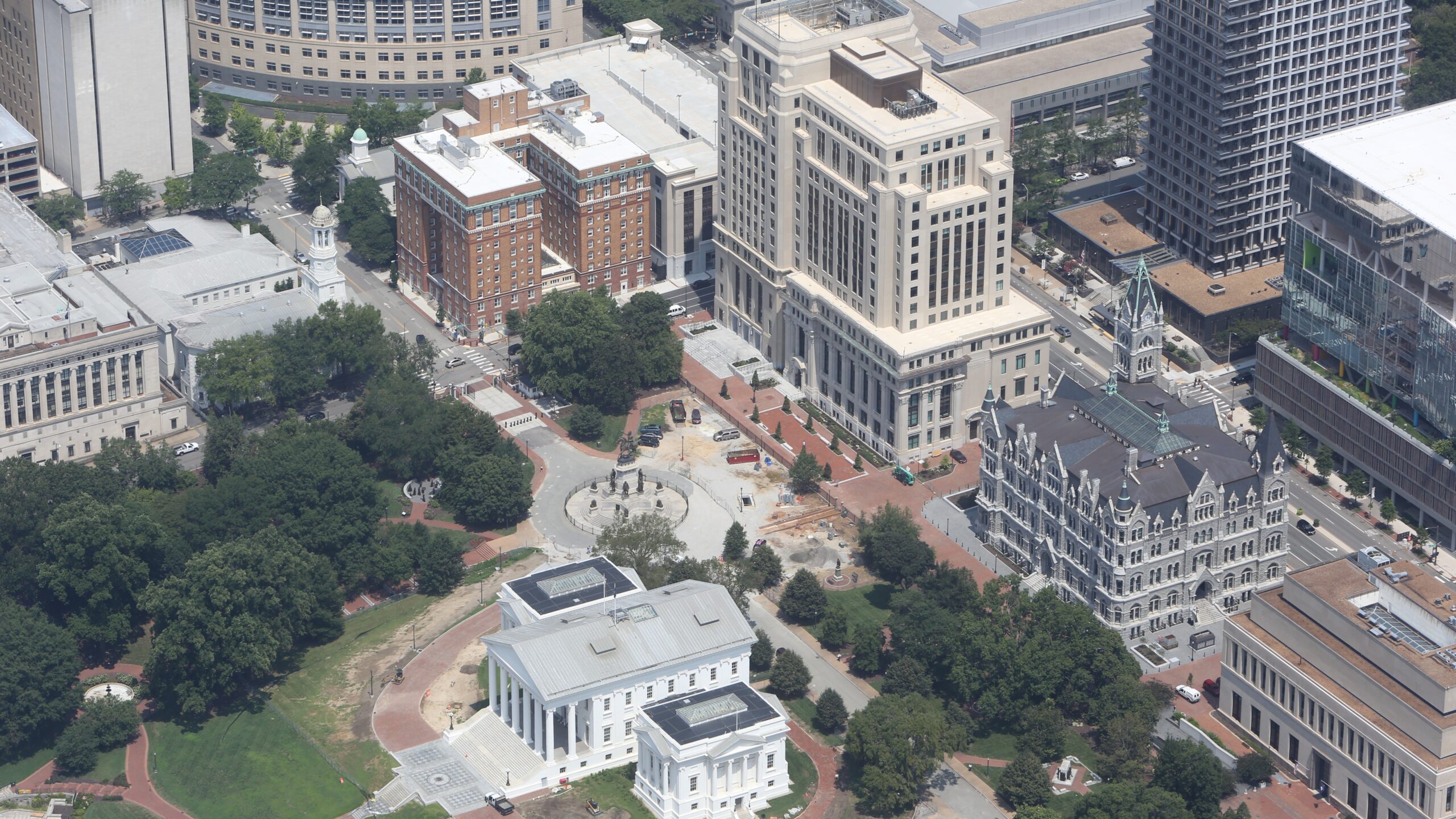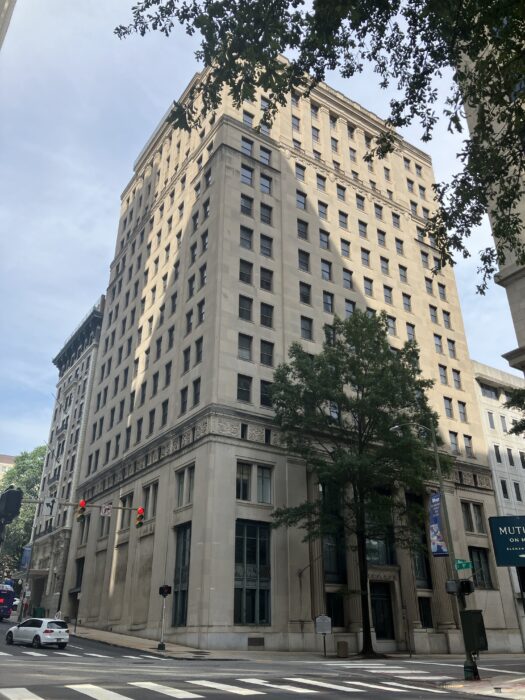As it reimagines Capitol Square and all of its downtown real estate holdings, the state government is now set to tear down one of its taller buildings in the financial district.
Last Friday the Commonwealth of Virginia received approval to demolish the 1920s-era, 12-story West Tower of the Pocahontas Building complex at 900 E. Main St.
That vote, along with a prior approval to raze the ’60s-era, eastern part of the property at 908 E. Main St., means the entirety of the 0.8-acre Pocahontas complex is on the chopping block to make way for the new “Commonwealth Courts Building.”
The future 300,000-square-foot structure will be the new home of the Supreme Court of Virginia and Virginia Court of Appeals.
Demolition is scheduled to begin in late 2025 or early 2026. The state is working with local architecture firm Baskervill on the design of the new courts building.
Last week’s vote was made by the Art and Architectural Review Board, a seven-person state board which makes recommendations to the governor’s office on proposed changes to state-owned properties.

The East Tower of the building is also set to be demolished. The eight-story building was most recently the temporary home for the Virginia General Assembly.
The state’s Department of General Services, which owns and maintains the Commonwealth’s Richmond-area real estate, was directed to seek the demolition of the West Tower by the General Assembly in the recently approved state budget.
The eastern portion of the Pocahontas complex is currently vacant and in recent years was the temporary home for the General Assembly while the governing body’s new building was under construction.
As for the West Tower, a spokesperson for DGS said numerous structural and efficiency issues with the building were discovered during the design process last fall.
The structural issues included its existing floors being unable to support modern mechanical, electrical, plumbing and fire protection systems. The efficiency issues included story heights that would have required special accommodations to connect the existing building with a new courts complex.
But not everyone was on board with the idea of demolition.
Cyane Crump, executive director of preservation nonprofit Historic Richmond, argued at last week’s meeting that the 101-year-old West Tower with its limestone façade and Ionic columns, was worth saving.
Crump said the West Tower, along with the nearby First National Bank building at 825 E. Main St. and the recently redeveloped Mutual Building, mark Richmond’s transformation into a modern metropolis and banking center in the early 20th century.
“These early skyscrapers not only make a significant contribution to Richmond’s architectural legacy, but also have proved eminently adaptable in recent years for modern office environments and as residential and hotel properties,” Crump told the AARB. “We believe this building also is suitable for rehabilitation and adaptive reuse.”
Crump also bemoaned a lack of public engagement around the decision to raze the building and said Historic Richmond would like to see the state more actively partner with the community and city in reshaping downtown. She pointed to the site of the former Virginia Employment Commission building at 703 E. Main St., where the state had previously been planning to build a 13-story office tower to house various state agencies, but those plans have been scrapped and the site is now a vacant gravel lot.
“This area is already a sea of parking lots and underutilized space,” Crump said. “This pattern of demolition, de-densification and suburbanization by the state around Capitol Square is the giant sucking sound of life, people, jobs and prosperity being pulled out of downtown Richmond.”
Mary Ann Petry, DGS’s senior project manager overseeing the Commonwealth Courts Building project, said that the West Tower site will not become a parking lot.
The AARB ultimately voted to approve DGS’ demolition request. Anne Smith, a member of the Virginia Museum of Fine Art’s Board of Trustees who also sits on the AARB, said of the West Tower, “It is beautiful; it’s just sad that it’s in the wrong place.”

The state recently began master planning the 46-acre Capitol Square district in the heart of downtown Richmond. (Courtesy SkyShots Photography)
The change of plans for the West Tower are the latest in the state’s yearlong process to reimagine its downtown real estate needs.
Last year it began the process of master planning the 46-acre Capitol Square area, and the fate of many buildings in that area remains unclear, including the Department of Transportation headquarters at 1401 E. Broad St. Earlier this year VDOT bought a sizable office building in Hanover County, though the agency did not comment on what its plans for it are.
The AARB meeting was held at the 26-story Monroe Building at 101 N. 14th St., whose own fate remains unclear.
The latest state budget also included language that directs DGS to study both the former VEC parcel at 703 E. Main St. and VDOT building at 1401 E. Broad St. “for potential development of a new state employee office building.” That study is due to be reported the Senate and House Appropriations Committees by Nov. 1 of this year.
DGS is taking all this on under the tutelage of a new director, Banci Tewolde, who was appointed by Gov. Glenn Youngkin in late June. Banci, whose background includes stints at the Virginia Department of Planning and Budget, Federal Bureau of Prisons and the Virginia Attorney General’s office, succeeds Joe Damico, who retired last year after over 20 years with DGS.
Also approved at AARB’s meeting last week was VCU’s planned Center for Arts and Innovation that’s set to rise at the corner of Broad and Belvidere streets. Demolition for the $253 million project began in the spring.
As it reimagines Capitol Square and all of its downtown real estate holdings, the state government is now set to tear down one of its taller buildings in the financial district.
Last Friday the Commonwealth of Virginia received approval to demolish the 1920s-era, 12-story West Tower of the Pocahontas Building complex at 900 E. Main St.
That vote, along with a prior approval to raze the ’60s-era, eastern part of the property at 908 E. Main St., means the entirety of the 0.8-acre Pocahontas complex is on the chopping block to make way for the new “Commonwealth Courts Building.”
The future 300,000-square-foot structure will be the new home of the Supreme Court of Virginia and Virginia Court of Appeals.
Demolition is scheduled to begin in late 2025 or early 2026. The state is working with local architecture firm Baskervill on the design of the new courts building.
Last week’s vote was made by the Art and Architectural Review Board, a seven-person state board which makes recommendations to the governor’s office on proposed changes to state-owned properties.

The East Tower of the building is also set to be demolished. The eight-story building was most recently the temporary home for the Virginia General Assembly.
The state’s Department of General Services, which owns and maintains the Commonwealth’s Richmond-area real estate, was directed to seek the demolition of the West Tower by the General Assembly in the recently approved state budget.
The eastern portion of the Pocahontas complex is currently vacant and in recent years was the temporary home for the General Assembly while the governing body’s new building was under construction.
As for the West Tower, a spokesperson for DGS said numerous structural and efficiency issues with the building were discovered during the design process last fall.
The structural issues included its existing floors being unable to support modern mechanical, electrical, plumbing and fire protection systems. The efficiency issues included story heights that would have required special accommodations to connect the existing building with a new courts complex.
But not everyone was on board with the idea of demolition.
Cyane Crump, executive director of preservation nonprofit Historic Richmond, argued at last week’s meeting that the 101-year-old West Tower with its limestone façade and Ionic columns, was worth saving.
Crump said the West Tower, along with the nearby First National Bank building at 825 E. Main St. and the recently redeveloped Mutual Building, mark Richmond’s transformation into a modern metropolis and banking center in the early 20th century.
“These early skyscrapers not only make a significant contribution to Richmond’s architectural legacy, but also have proved eminently adaptable in recent years for modern office environments and as residential and hotel properties,” Crump told the AARB. “We believe this building also is suitable for rehabilitation and adaptive reuse.”
Crump also bemoaned a lack of public engagement around the decision to raze the building and said Historic Richmond would like to see the state more actively partner with the community and city in reshaping downtown. She pointed to the site of the former Virginia Employment Commission building at 703 E. Main St., where the state had previously been planning to build a 13-story office tower to house various state agencies, but those plans have been scrapped and the site is now a vacant gravel lot.
“This area is already a sea of parking lots and underutilized space,” Crump said. “This pattern of demolition, de-densification and suburbanization by the state around Capitol Square is the giant sucking sound of life, people, jobs and prosperity being pulled out of downtown Richmond.”
Mary Ann Petry, DGS’s senior project manager overseeing the Commonwealth Courts Building project, said that the West Tower site will not become a parking lot.
The AARB ultimately voted to approve DGS’ demolition request. Anne Smith, a member of the Virginia Museum of Fine Art’s Board of Trustees who also sits on the AARB, said of the West Tower, “It is beautiful; it’s just sad that it’s in the wrong place.”

The state recently began master planning the 46-acre Capitol Square district in the heart of downtown Richmond. (Courtesy SkyShots Photography)
The change of plans for the West Tower are the latest in the state’s yearlong process to reimagine its downtown real estate needs.
Last year it began the process of master planning the 46-acre Capitol Square area, and the fate of many buildings in that area remains unclear, including the Department of Transportation headquarters at 1401 E. Broad St. Earlier this year VDOT bought a sizable office building in Hanover County, though the agency did not comment on what its plans for it are.
The AARB meeting was held at the 26-story Monroe Building at 101 N. 14th St., whose own fate remains unclear.
The latest state budget also included language that directs DGS to study both the former VEC parcel at 703 E. Main St. and VDOT building at 1401 E. Broad St. “for potential development of a new state employee office building.” That study is due to be reported the Senate and House Appropriations Committees by Nov. 1 of this year.
DGS is taking all this on under the tutelage of a new director, Banci Tewolde, who was appointed by Gov. Glenn Youngkin in late June. Banci, whose background includes stints at the Virginia Department of Planning and Budget, Federal Bureau of Prisons and the Virginia Attorney General’s office, succeeds Joe Damico, who retired last year after over 20 years with DGS.
Also approved at AARB’s meeting last week was VCU’s planned Center for Arts and Innovation that’s set to rise at the corner of Broad and Belvidere streets. Demolition for the $253 million project began in the spring.




What a shame, tearing down more of Richmond’s good architecture….
I agree as far as the west tower is concerned – but the east tower – meh
I agree, be cool if they copied a new building beside it in similar architecture.
I love the heck out of art deco.
Zach, interestingly enough, Baskervill’s original design did exactly that. The renderings are absolutely gorgeous – and aside from whatever materials might be used for the cladding, as previously designed, the new building looks like it came right out of that 1920s-’30s era, architecturally.
It is simply amazing.
Ideally the state would see themselves as stewards of the West Tower and not as the owner. A private developer would be much less likely to “(suck) . . . life, people, jobs, and prosperity . . . out of downtown Richmond” than the state is. Similarly, the Art Deco West Hospital on Broad Street could be an amazing conversion to apartments but MCV feels a stronger sense of ownership than stewardship and would like to demolish it. I lived close to the capital for 7 years and often jogged through the capital complex at all times of the day.… Read more »
What a shame. Pretty building.
The AARB & DGS have their priorities wrong. They should be focused on demolishing the Monroe Building before they do anything else. It’s hideous and doesn’t fit in. Pocahontas West needs to be preserved and rehabilitated. It’s historic, classy, beautiful and still has 100’s of years of usefulness. The new courts building should be built in Court End on the eastern side of Capital Square. It’s an ugly wasteland there and nothing will be missed.
What I was thinking, if you got the itch to tear down something take out Monroe and let the Courts have it for a new building. Anyone notice that EVER state building before it comes down has “numerous structural and efficiency issues with the building” yet if a private developer was given the property for say apartments it would be no issue to redevelop. Also what “structural issues” lack of routine maintenance??
Government overspending.
There you go, I said it.
Not every building is a cost effective conversion opportunity for the private sector. Sometimes the floor spacing just doesn’t work.
I promise you a private developer through a competitive IFB with the right sales price one could make it work but in this case state got it 1970s when parent bank owner left and like all other state buildings renovation projects they almost always (90% of the time) want to tear it down to build a new building. Tell me with technology and even back office court employees still teleworking several days a week, why does state Supreme Court and VA Court of Appeals (that both need 1 courtroom each) and their 100 or so employees need that much more… Read more »
I might be mistaken, but I don’t believe the state bought the building in the ’70s. United Virginia Bank was headquartered in the building until 1983, when they moved across the street and down one block to what is now the Truist Center.
The grey-granite tower at 10th and Cary was originally called the UVB Building.
Oh and btw, I’m 100% with you on saving/keeping Pocahontas West.
Apologies in advance for the length of this response. Agreed with one caveat – no demo for EITHER Pocahontas West or the Monroe Building. If the state has no “use” for either of them due to any number of safety issues, efficiency, need for modernization of internal structure, workings, etc., then sell. Given the rate at which the state government is actively fleeing downtown Richmond and otherwise consolidating office space due to changes in the WFH vs in-office paradigm in the wake of the pandemic, the question begs: does the state actually NEED the land? The city would certainly be… Read more »
Someone should definitely hire you as a planner.
Peter, great ideas. You have my vote for mayor!!
Some of the best buildings ever built in Richmond were designed by Clinton & Russell Architects. 900 E. Main is one of them…an absolute shame on moving ahead with that demolition.
This is depressing.
Could not agree more, Shawn.
Rather unfortunate that in later life the building developed a brutalist east tower tumor that even Kallman Mckinnel & Knowles wouldn’t produce. In essence: a death sentence.
Why can’t the new courts building go on a vacant/under utilized property nearby? Demolishing such an architectural gem is crazy when there are multiple surface lots around Governor St and 14th St (never mind the old VEC building’s vacant lot).
I appreciate the coverage and reporting on this topic. The next meeting of the AARB is August 2nd, 2024, 10AM. AARB meetings are open to the public. If you wish to attend or provide public comment email aarb@dgs.virginia.gov. Remember to ask staff about the public comment rules! The public always appreciates the effort that staff puts estimating the specifics trade offs of reuse vs tear down/rebuild in a project. There are often significant differences and constraints between those two options, not the least of which are accommodating the future client’s needs the existing building. There can also be a big difference… Read more »
Thanks so much for the heads-up on this, Nick. This is great information and good to know.
I take it y’all have never actually worked in these buildings. They’re a hodgpodge of mismatched floors and ancient systems that are outdated and falling apart. If you want to make them practical and safe for today’s work environment and safety standards while saving the exterior you’d basically have to do what they did with the GAB- which would be significantly more expensive than a tear down and rebuild.